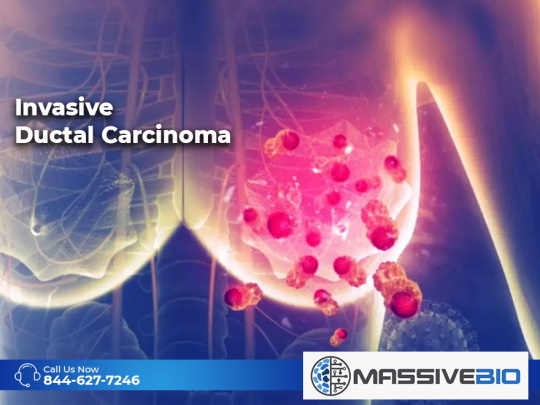Invasive ductal carcinoma (IDC) is the most common form of invasive breast cancer, which means it has spread into the surrounding breast tissues. IDC accounts for around 80% of all invasive breast cancers. According to the American Cancer Society, more than 180,000 women in the United States are diagnosed with invasive breast cancer each year.Invasive ductal carcinoma can be detected as breast cancer during a physical exam or imaging tests such as a mammogram. If cancerous cells have spread beyond the milk duct, the diagnosis advances to invasive ductal carcinoma. Inherited genetic mutations in the BRCA1 and BRCA2 genes have been studied and proven as risk factors of some invasive breast cancers.
What is Invasive Ductal Carcinoma?
IDC develops in the lining of the milk ducts, that are responsible for carrying milk to the nipple from the lobules of the breast. The cancer can spread to other parts of the body through the blood or lymphatic systems. Over time, invasive ductal carcinoma can spread to the lymph nodes and possibly to other areas of the body.
There are three grades assigned to IDC that range from 1 to 3. The grades are determined by how the cancer appears under a microscope. The grade gives an insight to how the cells will behave and what treatments have the best chance to be effective.
- Invasive ductal carcinoma grade 1: Known as well differentiated, the cells look and behave almost as normal breast cells. These cells are less likely to spread than higher grades and are usually slow growing.
- Invasive ductal carcinoma grade 2: Known as the moderate grade, the cells look a bit more abnormal and divide a little faster. The cells grow faster than in grade 1 IDC but are less likely to spread than grade 3.
- Invasive ductal carcinoma grade 3: Also called poorly differentiated, the cells do not behave like healthy breast cells. They are more likely to spread and divide much quicker than normal cells.
Invasive ductal carcinoma (IDC), also referred to as infiltrating ductal carcinoma, signifies a primary form of breast cancer that originates in the milk ducts and possesses the potential to invade surrounding breast tissue. As it progresses, it can evolve into metastatic breast cancer, a stage where cancer cells have spread beyond the original site to other parts of the body, necessitating a more aggressive and targeted approach to treatment. Advances in cancer research have led to the development of targeted therapy, a form of treatment designed to attack cancer cells specifically based on their unique characteristics, without affecting normal cells. This approach holds promise for treating even high-grade IDC by focusing on specific genetic or protein targets found in cancer cells, thereby offering a potential for more effective and less toxic treatments.
What are the Treatment Options for Invasive Ductal Carcinoma?
Most women with invasive breast cancer first undergo surgery to remove the tumor. Surgical treatment for invasive breast cancer follows the same approach, whether the patient has an invasive lobular or invasive ductal cancer. If currently inoperable, chemotherapy may be given prior to surgery to shrink tumors and destroy rapidly dividing cancer cells, or after the surgery to address any residual cancer cells and reduce the likelihood of recurrence.
The most common treatments for IDC include:
- Lumpectomy
- Mastectomy
- Sentinel lymph node biopsy
- Axillary lymph node dissection
- Radiation therapy
- Chemotherapy
- Hormonal therapy
Understanding the type of breast cancer a patient has is crucial for determining the most effective treatment plan. Among the common types of breast cancer, In situ DCIS (ductal carcinoma in situ) and invasive cancers such as IDC (invasive ductal carcinoma) and lobular carcinoma play significant roles in diagnosis and treatment decisions. For early detection, imaging techniques such as ultrasound and mammogram are essential tools. These methods can help identify abnormalities in the breast that may indicate the presence of cancer, with a mammogram being particularly effective in detecting early stages of DCIS.
Upon detecting abnormalities, a biopsy is performed to obtain a sample for histology, a process that examines the tissue under a microscope to determine the type of cells involved. This pathology report can distinguish between lobular carcinoma, which originates in the milk-producing lobules, and IDC, which begins in the milk ducts. The distinction is crucial as it influences the choice of treatment. While both types may require surgery and potentially radiation or chemotherapy, understanding the specific pathology of the cancer allows for more tailored and effective treatment plans, including the decision between lumpectomy and mastectomy, as well as the need for sentinel lymph node biopsy or axillary lymph node dissection to assess the spread of cancer.












